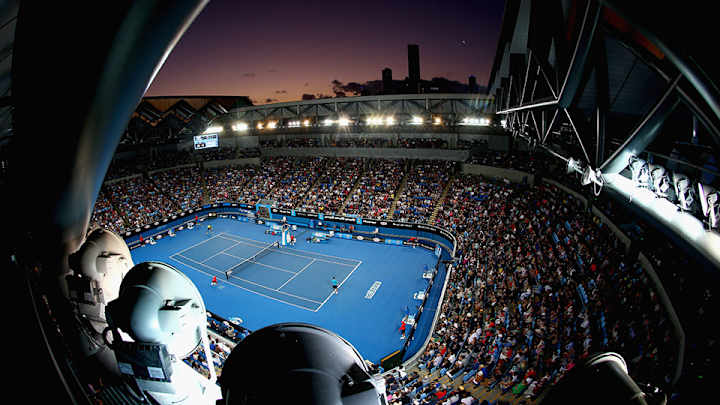What makes the 2016 Australian Open courts unique to Melbourne?

With an extra layer of rubberized cushion built in, the court system for the Australian Open in Melbourne is a bit more cushiony than that of the Billie Jean King National Tennis Center in Flushing Meadows.
John Graham, managing director of California Sports Surfaces, the makers of Australian Open courts and the Boston-based parent company of court surface brands, says the Plexicushion Prestige system used in Melbourne since the 2008 tournament has three layers of acrylic mixed with large rubber granules and then an additional three layers of acrylic mixed with smaller rubber granules on top of that—one more layer than what's used in the DecoTurf system Graham supplies for the U.S. Open.
“It gives just enough cushion so you can feel it and your body is thankful the next day,” he says. “But there is no change in the playing characteristics of the ball bounce.”
That’s because the bounce of the ball gets determined by the top layer, the color coating that mixes with sand to texture the surface and control the speed of play.
“We have formulas that we send out to independent labs that are accredited by the International Tennis Federation and that lab performs testing on those samples,” he says. “It is a science. They are measuring the coefficient of friction of the court and coefficient of restitution of the ball coming off the court.”
• MORE: A look at the nomadic history of the Australian Open venues
The lab testing combines these readings to give every surface a “court pace rating,” or the speed of the court. Graham says they slow down and speed up the surfaces by varying the amounts and particle size of silica sand added to the acrylic finish. For example, at Indian Wells in the California desert, the tournament wants to slow the ball down slightly in the low-humidity environment, requiring Graham’s team to up the silica to grab the ball on the surface. Every tournament—and every surface—has distinct needs.
The Prestige system, Graham says, is a different formula than DecoTurf because of its varied composition and playing characteristics. Plexicushion Prestige was designed to handle the extreme weather, such as court temperatures in Melbourne that can reach 147 degrees. “It is the formulation of the system,” he says, “players are getting the same consistent playing characteristics (no matter the weather) and from court to court.”
The Australian Open hasn’t always had the same style of court, though. While historically the tournament was played on grass, it switched to Rebound Ace, also a cushioned court system now owned by California Sports Surfaces, when it moved to Melbourne in 1988. Plexicushion took over for the 2008 tournament.
Graham says that when Craig Tiley took over Tennis Australia, the former coach at the University of Illinois was quite familiar with the Plexicushion product, a popular option throughout the NCAA.
With all the rubber layers figured out and the proprietary mix for playing characteristics of the top layer decided, the most visually striking choice comes in the pigments added to the top layer. While the U.S. Open’s courts offer blue for inbounds and green for out-of-bounds, Tennis Australia wanted its own look. An all-blue look.
In a visual cue now modeled across much of Asia, Tennis Australia opts for Velocity Blue inbounds and a lighter True Blue for out-of-bounds, making up the trademark "Australian Open True Blue" courts.
Tim Newcomb covers stadiums, sneakers and technology for Sports Illustrated. Follow him on Twitter at @tdnewcomb.

Based in the Pacific Northwest, Tim Newcomb covers stadiums, sneakers, design, training and technology across all sports.